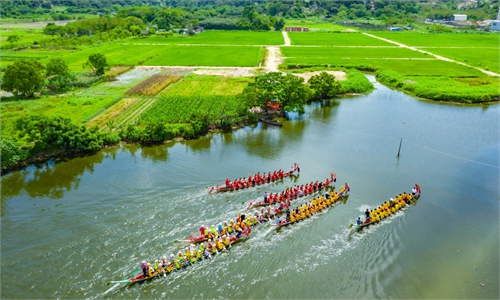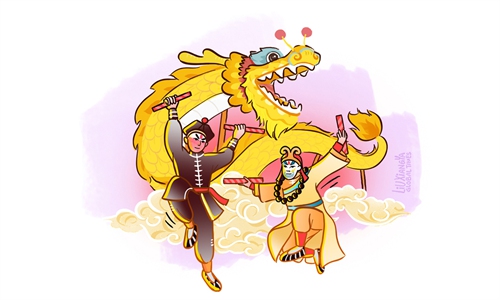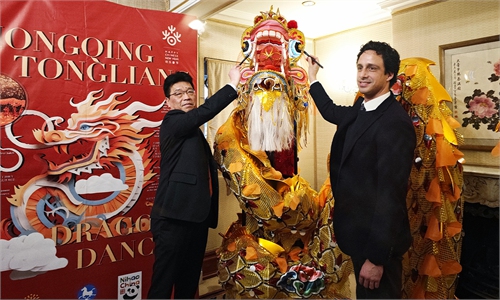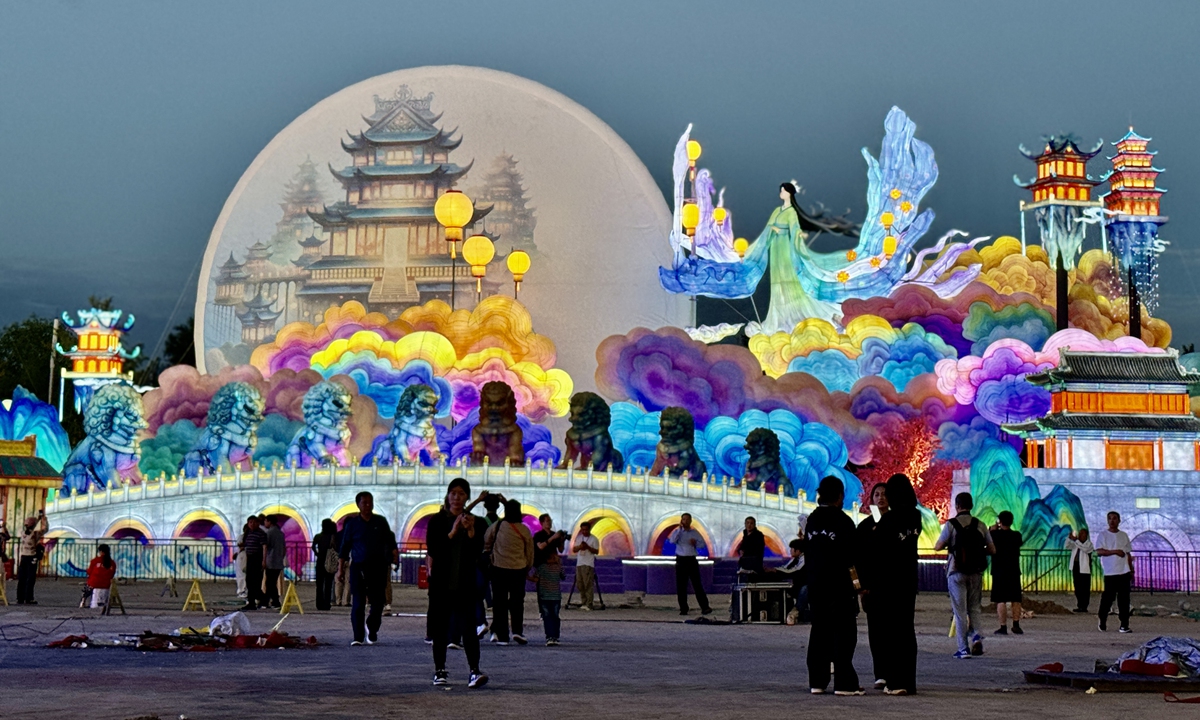
People attend a lantern festival in Beijing to celebrate the Mid-Autumn Festival. Photo: VCG
Editor's Note:
Mid-Autumn Festival, a celebration that has spanned centuries in China, is synonymous with the ancient practice of moon worship. Falling on the 15th day of the eighth month of the Chinese lunar calendar, when the moon is at its fullest and brightest, the festival has been bestowed with the meaning of unity, with legends such as Chang'e and the moon rabbit enriching its heritage. For Chinese people, the festival is of special ethical significance, while the thought of reuniting with family on this occasion has been a sentiment and mind-set for hundreds of years. The symbolic snack known as mooncake, a traditional offering to the lunar deities and a seasonal treat, has now evolved into a cultural brand representing China.
In this special issue, Global Times reporters Chen Xi, Li Hang and Sun Langchen will help you understand how and why Chinese celebrate this day even though many customs are changing with the times. As the Mid-Autumn Festival, which falls on Tuesday this year, is being celebrated across the whole world nowadays, the festival has also evolved in different ways.
Looking at the Moon and Longing for One Far Away
Zhang Jiuling (Tang Dynasty)
"Over the sea the moon grows bright;
We gaze on it far, far apart.
Lovers complain of long, long night;
I rise and long for my dear heart.
Candles blown out, fuller is light;
My coat put on, I'm moist with dew.
As I can't hand you moonbeams white,
I go to bed to dream of you."
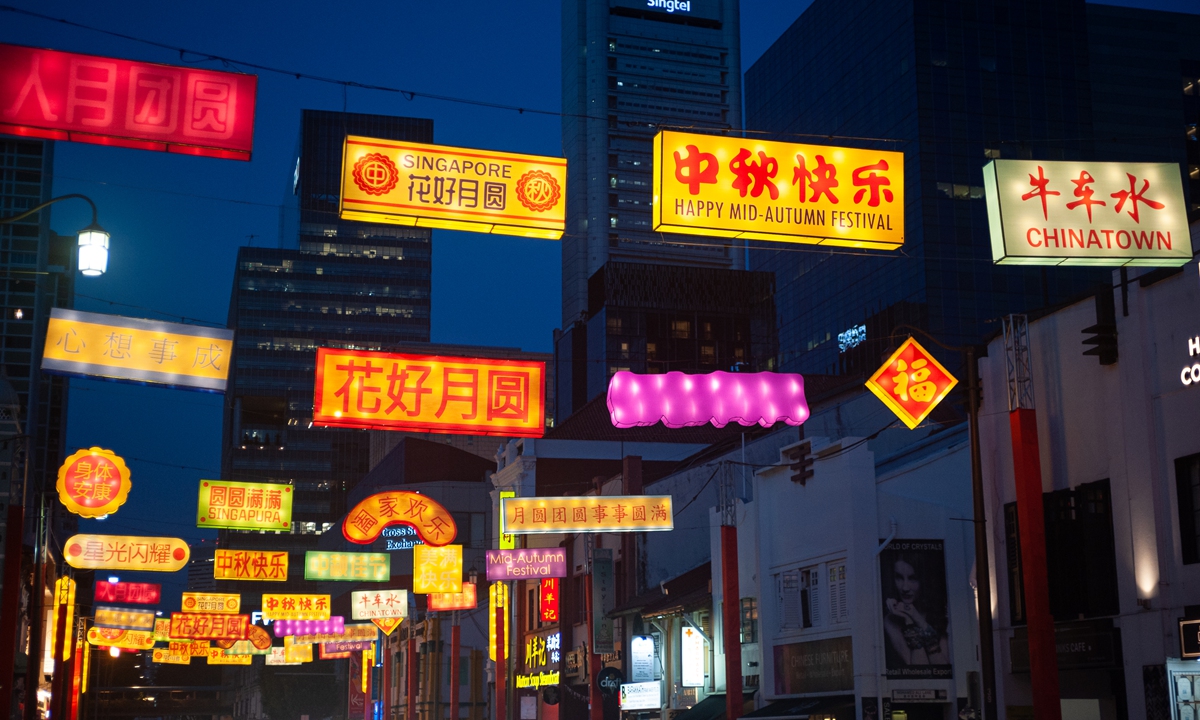
A view along South Bridge Road decorated with illuminated colorful banners during the Mid-Autumn Festival in Singapore. Photo: VCG
In ancient times, the night of the Mid-Autumn Festival was marked with grand altars adorned with mooncakes, fruit, and other offerings. Families would gather under the lunar glow, positioning the image of the moon god in the direction of the full moon. As red candles burned brightly, family members would take turns paying homage to the moon as the matriarch of the household sliced into a round, reunion mooncake, a gesture signifying the completeness of family bonds.
Nowadays, people celebrate the festival in more creative ways. Experts told the Global Times that both innovative and traditional forms of celebrations are ways to express one's cultural identity and communicate feelings, and these are better expressed through objects or certain mediums.
In Beijing, Tianjin, and Shandong Province, the Tu'er Ye, or Lord Rabbit, emerged as a new festival symbol after the Ming and Qing dynasties (1368-1911). The rabbit god represents a secularized imagination of the Jade Rabbit that lives on the moon and is traditionally depicted pounding medicinal herbs.
"We can see that this is a trend with a certain global significance. The Lord Rabbit can serve as a globally shared deity figure during the Mid-Autumn Festival. In the West, the rabbit also symbolizes trust , making it a universally shareable symbol," Xiao Fang, head of the Department of Anthropology and Folklore Studies at Beijing Normal University, told the Global Times.
Moon-viewing tours
As this is the time of the year when the moon is at its fullest, "Chinese-style night tours" have become a new choice for people to celebrate the holiday, including spending the night with family and friends in a garden, or even taking a moon-viewing flight to admire the moon from a closer vantage point.
This year, China will celebrate with a three-day holiday running from September 15 to September 17.
Popular among younger travelers, activities such as moon gazing and exploring historical sites have drawn crowds to cities across the country, particularly to boat tours, ancient gardens, and bustling night markets.
According to data from Tongcheng Travel, in the week leading up to September 5, searches related to domestic ancient towns and garden night tours during the Mid-Autumn Festival holiday saw a 77 percent week-on-week increase, while searches for night cruises increased by 42 percent.
In Suzhou, East China's Jiangsu Province, a city renowned for its classical gardens, a series of moon-viewing night tours are being introduced, offering travelers a visual feast.
As night falls and lanterns illuminate the streets, the thousand-year-old Tiger Hill Pagoda in Suzhou shines brightly under the lights. During the Mid-Autumn Festival, visitors can enter the lower level of the pagoda, without reservations, to experience the ancient structure up close and appreciate its historical significance.
With the moon-viewing tradition at the heart of these celebrations, an increasing number of travelers are also flocking to take special "moon-viewing flights." Multiple airlines have launched unique routes designed to offer passengers a closer view of the moon from the cabin during flight.
For example, China Southern Airlines' Hunan branch plans to operate over 80 flights during the Mid-Autumn Festival to provide moon-viewing opportunities, taking into account factors such as moonlight and flight routes.
In ancient times, the Mid-Autumn Festival was one of the few occasions when night markets were held, making it an important time for socializing. In the past, as people crafted and lit paper lanterns, scholars dreamed of achieving fame, while the young prayed for love. Today, the tradition continues, with people across China enjoying evenings out with their friends.
Cultural fusion mooncakes
Besides trendy night tours during the festival, the traditional mooncake has also transcended its identity as a simple festival snack to become a vessel for well-wishes.
From the plain, round pastries adorned with simple patterns to the myriad fillings of recent years, and now to the creative mooncakes that artfully incorporate cultural elements, the cultural "flavor" of mooncakes has grown increasingly significant.
This year, creative mooncake products in major universities have been a feast for the eyes. From mooncakes featuring Peking University's iconic campus landscapes to ones from Beijing University of Chinese Medicine that have been infused with traditional Chinese medicinal ingredients, the creativity of these academic institutions has been remarkable. Museums have also joined the trend, launching their own cultural and creative mooncakes. For example, the Chinese Archaeological Museum has incorporated five representative "dragon" motifs from its collection into the design of their mooncakes.
A standout mooncake gift box this year is the "Clasp the Moon in the Heaven Mooncake Gift Set," a collaboration between the Suzhou-style mooncake maker, Daoxiangcun, and the popular video game Black Myth: Wukong.
Zhou Liyuan, a manager with the time-honored brand, told the Global Times that the overall design draws inspiration from cultural elements in Journey to the West, upon which the game is based, and combines traditional pastry-making skills with modern aesthetics. The gift box unfolds like a flip-book when opened and features not only the game's characters but also scenes from the game.
"Currently, the gift box is mainly sold domestically and is a hot-seller with supply not meeting demand. However, some foreign customers in China are purchasing this gift box and sending it to their relatives and friends overseas by mail," Zhou said.
Zheng Changling, a research fellow at the Chinese National Academy of Arts, told the Global Times that the popularity of cultural and creative mooncakes, especially among young people, stems from their transformation of the traditional, somewhat rigid image of mooncakes. However, the real reason for their appeal lies in the way they embed culture within these pastries.
"It can be said that while mooncakes once represented the warmth of family reunion, they now offer a taste of national trends, cultural styles, and even cultural confidence," he said.
A global festival
As more people both in China and abroad celebrate the traditional festival, the Mid-Autumn Festival highlights both new and traditional ways of honoring this beloved holiday, reflecting its continued significance in contemporary life.
In Wuhan, Hubei Province, a Chinese-style mecha show at Happy Valley marks a groundbreaking approach to celebrating the festival. This show features interactive mechanical representations of legendary Chinese figures such as Zhao Yun, a military general who lived during the late Eastern Han Dynasty (25-220) and early Three Kingdoms (220-280) period, Erlang Shen, a god in Chinese folk religion and Taoism. Visitors can engage with these larger-than-life characters, offering a fresh and captivating way to experience Chinese mythology and cultural heritage.
In addition, the lantern festival in Beijing also promises to be the largest lantern display in the city's history. It will showcase over 200 creative lantern displays, including a remarkable 10-meter-tall phoenix lantern made from colored blow-molded paper and transparent acrylic. The festival will also feature more than 150 specialty shops and various themed activities, including performances and interactive events. This extensive and imaginative presentation of lanterns reflects a deep appreciation for both traditional craftsmanship and modern design.
"Modern urban life is becoming increasingly atomized, and we should use the Mid-Autumn Festival as an opportunity to encourage more interaction among people," said Xiao.
The global significance of shared figures is also reflected in other countries. The light-up ceremony in Singapore's Chinatown has introduced a novel feature: a digital riddle-solving activity. This new addition aims to engage younger generations by combining traditional festival elements with modern technology.
Josephine Teo, Minister for Digital Development and Information of Singapore, emphasized the importance of blending tradition with innovation, noting that this approach not only preserves cultural heritage but also makes the festival more relevant to the diverse demographics of today.
"Family and national unity, as well as the integrity of the nation, are deeply significant concepts in Chinese thought. No matter where Chinese people go, they carry with them this sense of national togetherness. This national psychological factor is not easily abandoned just because they are abroad," Li Hanqiu, a veteran folk custom expert who first proposed the Mid-Autumn Festival be designated a public holiday, told the Global Times.
He noted that through the moon, emotions are conveyed, and in this way, the feelings of reunion also merge into a sense of national identity. The shared act of gazing at the moon from afar is not only an expression of longing for loved ones but also a longing for one's homeland.
